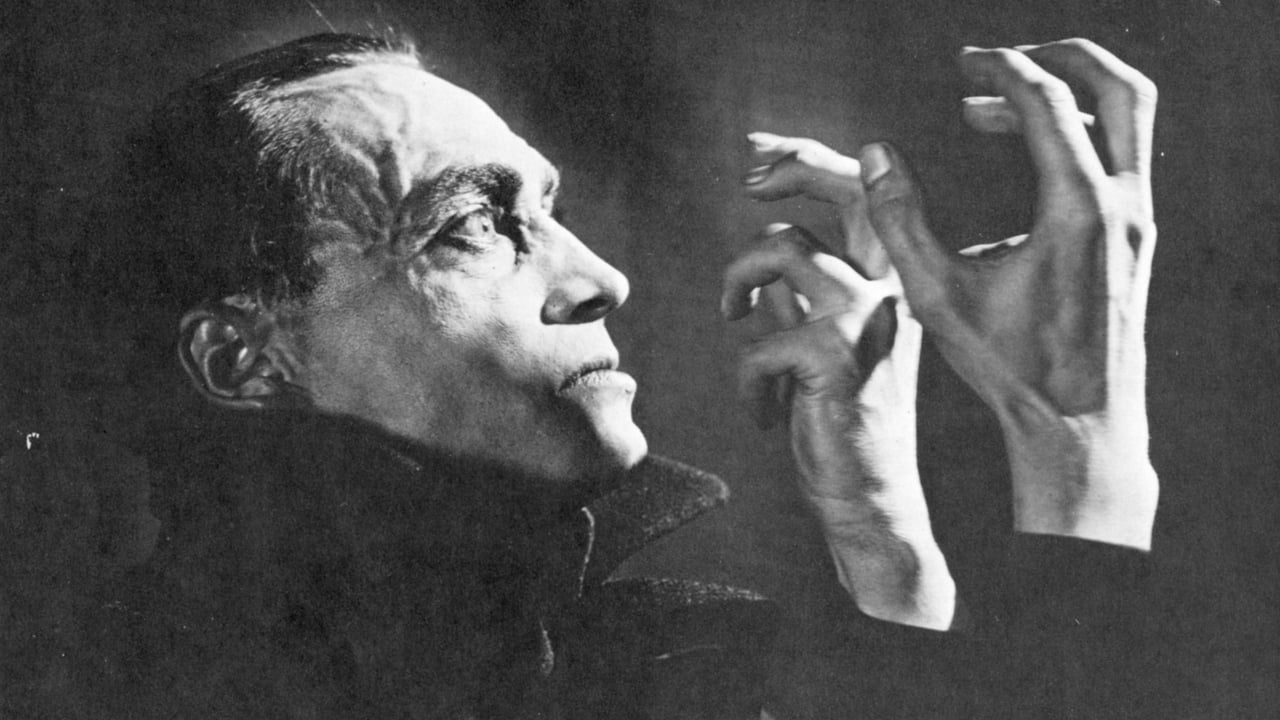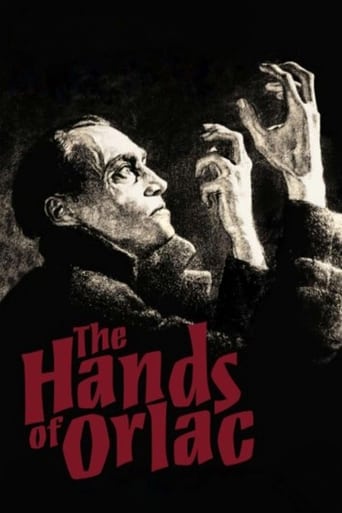

Some things I liked some I did not.
... View MoreA lot of fun.
... View MoreMostly, the movie is committed to the value of a good time.
... View MoreThe movie really just wants to entertain people.
... View More"Orlacs Hände" or "Orlac's Hands" is a black-and-white silent film from over 90 years ago. It was directed by Robert Wiene, the man behind the famous Caligari movie. In its original version, the film ran roughly 90 minutes, but the new version I saw has over 110 minutes, probably because of less frames per second. Anyway, Conrad Veidt is one of Germany's most known silent film actors, so he certainly can carry a film like this. His most known role is probably in "Casablanca". In my opinion, the idea was nice in here. A piano player has a terrible accident and loses both his hands. A surgeon gives him a new pair, but these are from a convicted and executed murderer. By now, you probably know that this is a mystery/horror film. The ending just takes it to another level. Yes it was fairly absurd that somebody else got the killer's head and now this was some meat puzzle story, but at least something interesting happened. This thrill near the end, however, is not enough to sit through almost 2 hours of this film. I am generally not the biggest silent film fan, so my opinion may be biased, but i found it a boring watch for the most part. This film did not get me interested in silent movies. Not recommended.
... View MoreIt's always odd to me that, when discussing the directors of the German expressionist movement in cinema, Robert Wiene's name is generally omitted from the conversation. Of course, "The Cabinet of Dr. Caligari" specifically is often mentioned, but Wiene himself rarely is. Instead, the "big three" of German expressionist cinema — Fritz Lang, F.W. Murnau, and Georg Wilhelm Pabst — seem to get all the attention. The reason I say I find this odd is because, from what I've seen, Wiene is clearly the consummate expressionist among the group. Lang, Murnau, and Pabst were great filmmakers, but a lot of their work from the '20s isn't even expressionistic to begin with. One of Pabst's early films was a work of New Objectivity (an early movement in cinematic social realism -- or, in other words, the polar opposite of the formalistically inclined expressionist movement). Half of Lang's and Murnau's respective silent bodies of work could be considered non-expressionistic, and even their expressionistic work pales in comparison to the sheer psychological angst exhibited by films like "The Cabinet of Dr. Caligari" and "The Hands of Orlac", which embody the expressionist modus operandi far more fully than any film I've ever seen by Lang, Murnau, or Pabst. Wiene is simply the most unrelentingly expressionistic filmmaker I've seen from the silent era. "The Cabinet of Dr. Caligari", with its surrealistic painted backgrounds conveying a distorted, twisted German landscape — and, by extension, a distorted, twisted German mentality in the wake of World War I — was highly innovative for its time. "The Hands of Orlac", if possible, is even more expressionistic, although the overall aesthetic is different here than it was in Wiene's previous film. Firstly, there's no color tinting here. This was crucial to the film. Color tinting in general I think takes away from a film's artistic integrity, and here, especially, the stunning black-and-white cinematography would have been completely destroyed by the use of tinting. Truly, the cinematography is brilliant in "The Hands of Orlac", as much as I've seen in any film from the silent era. The atmosphere is so thick, the mood so dark, the style so Gothic, the tone of the film so heavy and bleak, that the film's aesthetic takes on an uncannily palpable texture. The lighting is fantastic. The use of darkness and shadows is a hallmark of expressionistic cinema, but never realized more masterfully than it is here. I was reminded very much of the film's of David Lynch, namely "Eraserhead", "Lost Highway", and "Inland Empire", films which refined the expressionist mode of cinema to its most viscerally and sensorily potent form. Unfortunately, the film's weakness is in the narrative. The mood and tone and atmosphere of the film are so amazingly brilliant that any elements of plot and story are secondary in priority, if not all together superfluous. But the film is based on a novel, and Wiene puts too much emphasis on realizing the narrative aspects of the source material. The actual action of the film is almost entirely redundant. Everything that needs to be said is said through the film's form, not its content, and yet too much attention is given to the content by the filmmaker. The ending of the film, specifically, is where it begins to lose traction. The film falls apart, to some extent, in the last twenty minutes or so, because it offers too much resolution. This is a flaw we see in virtually all German expressionist films, and in silent cinema in general from this time period. The medium of cinema was still in its childhood and hadn't yet learned important facets of the art of filmmaking such as subtlety, ambiguity, et cetera. Lynch's gift was his ability to take expressionism to the next level, by doing what Wiene was unable to do here, which is to apply on a content level, not just a formal one, the anxiety and fear and bleakness that define the expressionist movement. Formally, Wiene captures the essence of expressionism impeccably with this film, but where he falls short is in transposing this essence from the film's form to its content. This can be done in a multitude of ways. Lynch did it by denying his audience almost any resolution whatsoever to the narrative, leaving the viewer alienated and uncomfortable, and thus enhancing the visceral impact of the viewing experience.That, however, is my only criticism of the film, along with the fact that, at times, the acting is overwrought. The exaggerated gestures and histrionics are somewhat like the horror equivalent of what you'd see in an early D.W. Griffith short for Biograph. This is common in silent cinema, though, and overall the film has more than enough strengths to compensate for any shortcomings.If "The Hands of Orlac" is narratively flawed, it's flawed in the execution of that narrative, not in its premise, which has a strong thematic core revolving around notions of personal identity, manipulation, submission, and the psychology that drives human action. Where does the essence of our natures as individuals come from? It is physical or mental? Does it originate in the body or in the mind? Wiene's film, as well as presumably the source material that it's based on, seems to suggest the latter, and this is consistent with German expressionist cinema in general, which places a strong emphasis on the psychological (from the psychic powers of Lang's Dr. Mabuse villain, to Pabst's "Secrets of a Soul", the original film about psychoanalysis).Along with Murnau's "Faust" and "Sunrise: A Song of Two Humans", this may be the best German silent film of the thirty-plus I've seen. It's unique and it's formally brilliant by any and all standards. I recommend it to fans of German expressionism, of silent films in general, and of cinema of any kind.RATING: 7.67 out of 10 stars
... View MoreA famous pianist (Conrad Veidt) has his hands crushed in a train accident, and he receives new ones through an experimental transplant. But whose hands were they before? The hands of a killer!This is a rather long film, probably more than it needs to be. The train wreck shots are beautiful, but go on a while, with the story being relatively simple.The focus here is more on Orlac's mental state, and less on the others in any way, with the love affair angle of "Mad Love" (its remake) completely absent. For fans of "Mad Love", this picture needs to be respected, as they clearly borrowed scenes (noticeably where Orlac meets his donor), but "Mad Love" is the superior film in many ways.
... View MoreTHE HANDS OF ORLAC is an exceptional German silent film and was remade in Hollywood just a few years later as MAD LOVE (starring another German, Peter Lorre). Both are well worth seeing, as they are quite different in how they portray the leading character.The film begins with a pianist (Conrad Veidt) having his hands tragically severed in an accident. However, in an amazing bit of surgery, the hands of an executed man are grafted seamlessly onto Orlac. Oddly, however, the pianist is haunted by the ghost of this dead man and the hands seem to have a mind of their own--with a strong desire to kill!! During all this film, Veidt overacts horribly--even for a silent film. In many ways, he acts much like the main character from THE CABINET OF DR. CALIGARI--a famous German Expressionist film made almost a decade earlier. For a 1919 film, this wasn't a problem, but by 1924 this sort of acting was becoming a bit passé. While not bad, you can't deny that he over-emotes here and there.Despite this over-emoting, the film is quite exciting and well-paced. The horror film has some wonderful twists and turns that keep the audience guessing and the excitement never lets up until the very end. One of the better silent films and fortunately the DVD print is top quality.
... View More